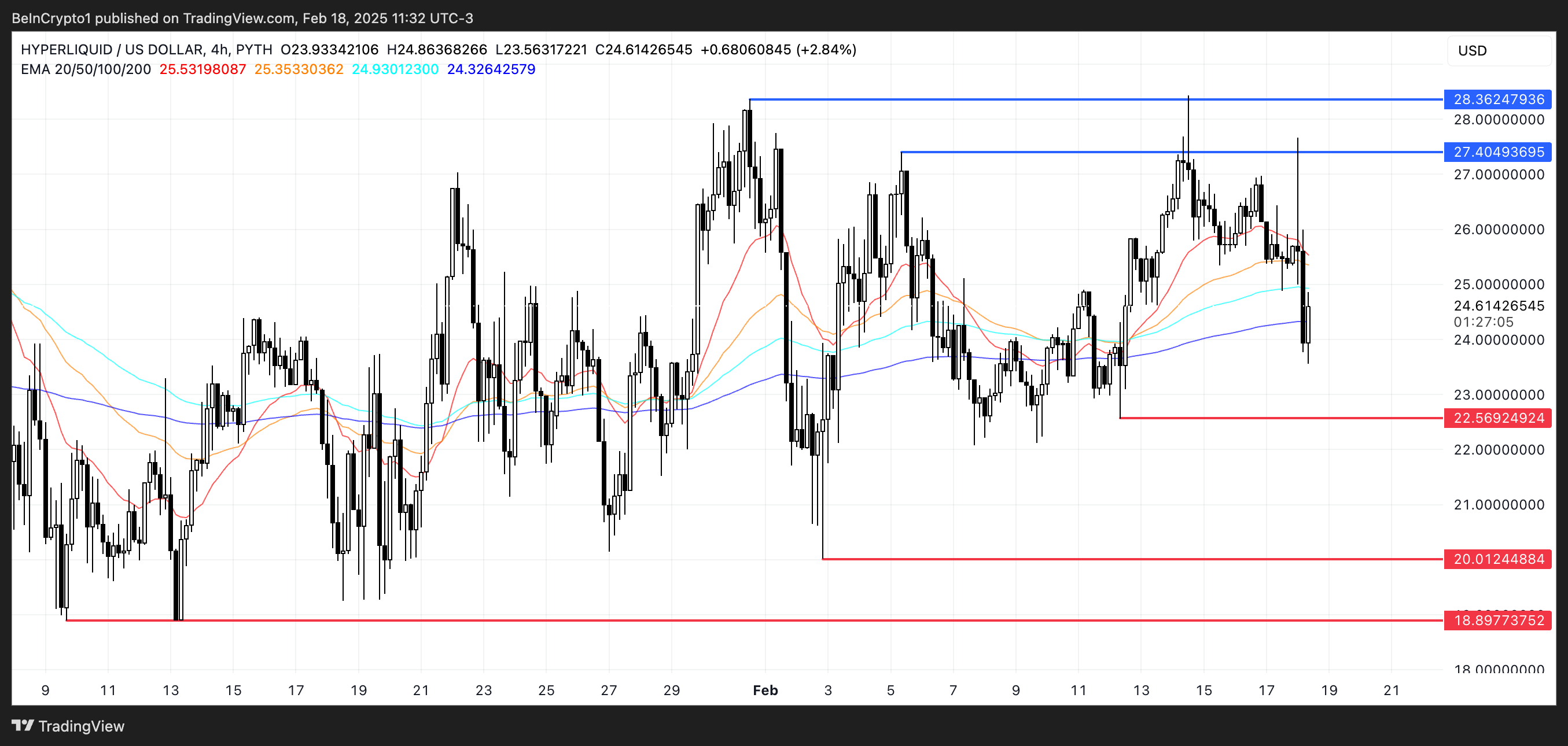-
Despite the recent launch of HyperEVM, Hyperliquid (HYPE) sees a 9% drop, indicating a potential struggle as bearish momentum increases.
-
Market indicators show HYPE’s ADX has fallen to 10.6, signaling weak trend momentum, and the RSI is approaching oversold levels.
-
“If the selling continues, HYPE might test the $22.5 support. Conversely, a breakout above $27.4 could potentially push it past the $30 mark,” analysts suggest.
Hyperliquid’s latest launch faces challenges as HYPE price dips 9%. With bearish signals rising, what does this mean for future price movements?
Hyperliquid Unveils HyperEVM Amidst Market Struggles
The introduction of HyperEVM aims to enhance Hyperliquid’s decentralized finance (DeFi) capabilities, bringing Ethereum Virtual Machine (EVM) compatibility to its trading platform. This key upgrade promises **programmability** and expands the potential for decentralized applications, yet the immediate market reaction has not reflected expected enthusiasm.
Despite the new features designed to improve user experience and DeFi engagement, the price of HYPE has declined significantly, emphasizing a **lack of buying momentum** post-launch. The performance of the cryptocurrency in the days following the HyperEVM release will be crucial in understanding market sentiment.

Selected Protocols and Chains Revenue. Last 24 hours, Last 7 Days, Last 30 Days, and Last Year. Source: DefiLlama.
Amidst these market dynamics, Hyperliquid remains a formidable player in the crypto sector, earning over **$8.5 million in revenue** in just the past week. This performance positions it among the top 20 earning applications, exhibiting resilience despite market volatility.
Technical Indicators Reveal Bearish Trends for HYPE
Analysis of the HYPE DMI indicates that the **Average Directional Index (ADX)** has decreased to **10.6**, down from **18.9** just days earlier. This drop suggests a **weakening trend**, indicative of a market without strong conviction. Generally, an ADX below **20** reflects a lack of directional authority.
Moreover, while **+DI** stands at **23.3**, slightly above a **-DI** of **21.4**, it points to some bullish pressure, albeit not enough to counteract broader bearish trends.

HYPE DMI. Source: TradingView.
Another concerning signal is the downward trajectory of the short-term EMA lines. Maintaining above long-term EMAs is crucial; however, a forthcoming bearish crossover could exacerbate selling pressure. HYPE’s **RSI has seen a sharp decline**, plummeting to **33.1 from 68**, signaling rapid bearish control over the market.

HYPE RSI. Source: TradingView.
Should the RSI continue its descent, it positions HYPE at risk of entering oversold territory, which could potentially spark a buying interest. Nevertheless, persistent selling pressure might delay any chances for meaningful recovery.
Evaluating HYPE Price Trends: What Lies Ahead?
Current analysis suggests that HYPE may be on the verge of a **death cross**, as short-term EMA lines trend toward a crossover beneath long-term EMAs, which is a classic bearish indicator. If the downward momentum continues, support levels could be tested at **$22.5**, and a failure to hold could see prices plummet to **$20** or below, a crucial psychological mark.
As the market digests the HyperEVM launch, a confirmed death cross would heighten selling pressure further, complicating any recovery efforts in the near term.

HYPE Price Analysis. Source: TradingView.
Nonetheless, if HyperEVM inspires newfound buying interest, HYPE could potentially reach the initial resistance at **$27.4**. A successful breakout beyond this threshold may lead to a retest of **$28.3**, with a sustained rally possibly pushing HYPE back above **$30**, a level it has not seen since late December 2024.
Ultimately, the crypto community’s reaction to the HyperEVM deployment will be pivotal in determining whether HYPE can reverse its current downtrend or continue to be ensnared by bearish forces.
Conclusion
In summary, Hyperliquid’s launch of HyperEVM signals an ambitious step towards smart contract integration, yet immediate price trends indicate weakness in investor confidence. The technical indicators highlight the need for traders to closely monitor market movements and behavior to gauge potential recovery or further declines in HYPE price.
